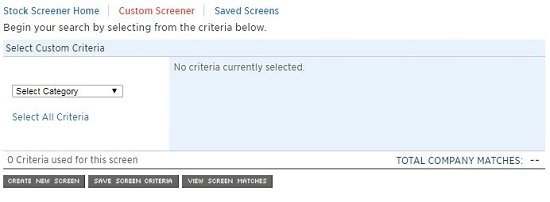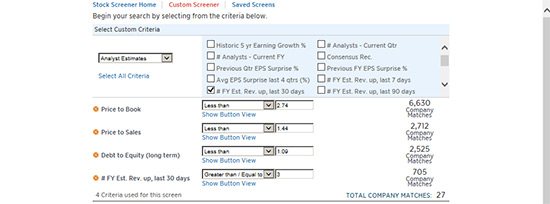Even "do-it-yourself" investors perfectly comfortable with handling their own money can be overwhelmed trying to make sense of all the information available.
And that's totally understandable.
Sifting through the information bombarding us every day is like being a five-year-old in a candy store with only enough money to buy one thing.
This won't be much help for the five-year-old candy shoppers, but luckily for us grown-ups, there's a really quick way to filter out the noise and zero in on a (really) short list of winning plays.
It's free to use, too, which means you can keep more of the juicy gains you're likely to pull in with this...
Using a Stock Screener for the First Time
I want to take a moment to demystify how to use a stock screen - and then we'll finish up with something I like to refer to as the "cherry on the top."
Now, it used to be that only professionals had access to anything beyond just basic screens - but that's all changed. With the explosion of information products on the Internet, individual investors now have access to many of the same screening tools that the pros use.
It's an additional input that will take you quickly to tremendous gains...
So let's spend a moment discussing a question I bet a lot of you are already asking: Why would I even want to use a screen in the first place?
If you've been investing for any length of time, you probably remember sifting through Value Line publications at the library in order to zero in on potential investment choices.
At the time these were great, but now the idea of going down to the library and reading through a printed edition of a book (with information that could be totally outdated by the time I get my hands on it) sounds about as sensible as using a rotary phone.
But, probably even more important, by using a screener you remove your emotional bias.
Every successful investor or trader has some sort of system or predetermined guidelines that dictate their investing decisions.
The benefit of a predetermined plan is that it takes a lot of the emotional bias out of your investing decisions. For instance, if your predetermined strategy calls for only investing in large-cap domestic stocks, then you would never even need to consider a small-cap company from a developing economy... no matter how sexy the story.
I could write a book, or a series of books, on the different strategies that investors use, but for the purposes of this article, let's stick to a pretty simple set of parameters based on Benjamin Graham's and Warren Buffett's value investing thesis.
For the purposes of today's article, I'm going to keep things simple and limit our screening criteria to some favorites from the school of value investing: price-to-earnings, price/sales, price/book, and debt/equity. For all these criteria, I only want to see (or allow to pass through the screen) stocks that are less than the median of the S&P 500.
There are a lot of free screening tools out there. Personally, I like the screens at CNBC.com.

Now, I certainly don't get compensation from these folks. I just think their screens offer a lot of functionality – and the best part is that they're free.
We'll use the CNBC screen today using the criteria below. Note: The S&P 500 moves, of course, so these numbers may change a bit from day to day or month to month. The best way to get the current median values I'm using is to "Google" them, like so ("what is the median price/book ratio of the S&P 500"):
[mmpazkzone name="end-story-hostage" network="9794" site="307044" id="138536" type="4"]
- Price-to-Earnings: less than the median of the S&P 500
- Price/Sales: less than the median of the S&P 500
- Price/Book: less than the median of the S&P 500
- Debt/Equity: less than the median of the S&P 500
If you're following along, you should get a list of approximately 203 companies.
Obviously that's not very helpful... and historically that list has barely outperformed the S&P 500.
Not bad, but not exactly worth the effort, either.
But... you're one input away from giving your returns a serious kick - the "cherry on top" I was talking about a moment ago...
Upward earnings revisions!
Now... Knock Returns Out of the Park
I've spent time in past articles discussing the how valuable upward earnings revisions are to stock performance.
If we update our previous screen criteria and only allow companies that have experienced three or more full-year upward revisions in the last four weeks, we get a totally different (much more profitable) outcome.
Here's what our new screen would look like:

Click to Enlarge
- Price-to-Earnings: less than the median of the S&P 500
- Price/Sales: less than the median of the S&P 500
- Price/Book: less than the median of the S&P 500
- Debt/Equity: less than the median of the S&P 500
- Full-Year Upward Revisions: three or more in last four weeks
In this case, you'd get 27 stocks - certainly more manageable than 203.
Over the past 13 months, these stocks delivered a 90.3% return, versus a 26.47% return from the S&P 500 over the same time period.
That's an eye-watering 241.3% performance edge.
Of course, the results of my screening example could easily deliver too many companies to invest in all at once, or maybe the idea of rebalancing every four weeks isn't your thing. I totally understand that.
You could make a valid argument that using a single sample time frame doesn't give us a large enough pool of data to study - and that would be fair, too.
But the most important thing is to start thinking about a standardized, unemotional way of identifying new potential investment ideas and using the cumulative knowledge of professionals, by way of analyst revisions, to help sift through a sea of potential choices.
Remember, analysts might not always be right, but they'll always have the ear of traders and institutions - with the kind of capital that can really put the wind in a stock's sails.
If you have some more screening ideas, take a moment to share them with fellow readers in the comments section below. In a few months, we can circle back and see whose ideas would have performed the best.
Up Next: Tiny Rocket Stocks Revealed Weeks Before They Bust Out
Already this year, 110 "Rocket Stocks" have doubled since Jan. 1, with historic gains reaching up to 3,386%.
But unless you're a company insider with information no one else has, it's almost impossible to pick these tiny Rocket Stocks – unless you learn the secret of this microscopic "tell" that appears just before they launch.
Follow Money Morning on Facebook and Twitter.
About the Author
Sid is the investment community's best-kept secret. Since 2009, he's served at Money Map Press as Director of Research, analyzing thousands of securities and profit opportunities for subscribers. He's an expert in identifying "alpha" potential in a wide variety of industries, but especially the small-cap sector, where he's discovered a pattern of profits that's almost foolproof.



